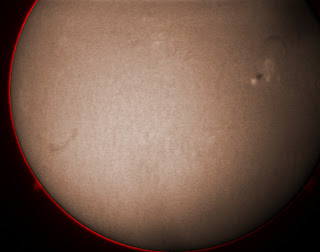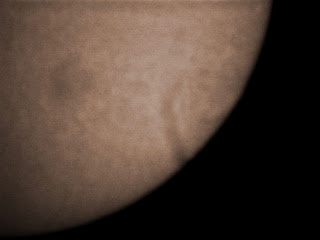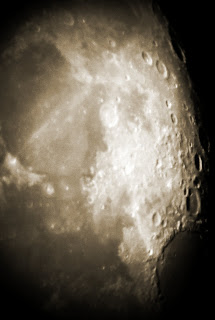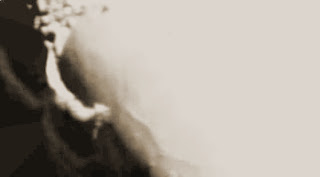Tuesday, April 30, 2013
April 2013 video
My photos are accompanied by "Space is Deep" by Hawkwind:
#astronomy April 2013 photos accompanied by Space is Deep by Hawkwind: http://www.youtube.com/watch?v=KuLmVq2ol4Y&list=PL--6h1svyG-FeycYHvs0ZwCSHl3LAi1xg …
Tuesday, April 16, 2013
R.I.P. Tom Pugh
If I have been quiet lately, it is because I lost my father in the early hours of Sunday April 14th. Although the exact cause of death is unknown, in a nutshell it was old age. He was 84.
He leaves my mum, my brother and I and our wives and children, all grown up.
He had a passing interest in astronomy and he was looking at my photos the day before he died.
I am proud to call him my father.
He leaves my mum, my brother and I and our wives and children, all grown up.
He had a passing interest in astronomy and he was looking at my photos the day before he died.
I am proud to call him my father.
Tuesday, April 2, 2013
April 2013
2nd
I started the month with a lunchtime binocular scan of the Sun and saw that the sunspot had rotated and grew larger.
3rd
1115 GMT: I checked the Sun with my PST and saw the sunspot accompanied by a nice prominence and most activity was around this region. Processing also revealed further prominences and a nice filament to the bottom left.
4th
It was cloudy during the day but cleared a bit at night. I was still recovering from a cold, so did not want to make things worse, so I tried a zenith shot at F/5.6, ISO 800 and exposure of 30 seconds with the DSLR. I didn't stay out with the camera but went out to collect it when the exposure time had clearly passed. The end result was a bit out of focus.
5th
A lunchtime binocular scan of the Sun revealed the large sunspot was showing umbral/penumbral shading.
Shortly afterwards, I checked the Sun in hydrogen alpha light. It wasn't as exciting as my last view but some surface details were visible.
6th
I bin scanned the Sun after local mid-day and saw that the sunspot had rotated.
At 1510 GMT, I did a hydrogen alpha shoot with my PST. Despite cleaning my optics, there was still a false filament in most of the close-ups. I didn't notice any prominences when I looked at the Sun but I saw them when I processed the photos.
I went out at 2020 GMT to find Comet Panstarrs, having missed a lot of the action due to a cold (which I was still recovering from) and bad weather. I started with the Pleiades (M45) and found that most of the stars showed really well. I also checked out the Orion Great Nebula (M42) and it showed really well, with the nebula covering more space than normal, despite the low elevation.
Unfortunately, the target area for the comet was quite murky. It was easy to see and the tail appeared straighter and less spread out than in the images I'd seen. The tail was about 1.5 to 2 degrees long. The Andromeda Galaxy (M31) was barely visible. The conditions around the comet did not encourage me to take any photographs and I had not recovered enough to do any webcamming of Jupiter nor do any constellation shots, which could wait for a clearer night and better health.
7th
It was far too hazy to think about hydrogen alpha viewing/photography, so I decided on a "white light" shoot instead. Despite some smaller sunspots in the Big Bear images, I was only able to see the large one. I used my Skymax 127 and compact digital camera to produce this shot.
8th
I bin scanned the Sun under poor conditions at lunchtime. Although I could see the sunspot, I was unable to make out umbral/penumral shading.
9th
The day was a complete white-out, so I reprocessed a series of solar shots from September 14th 2011.
11th
Due to another wet day, I reprocessed some lunar shots from September 14th 2011.
It cleared unexpectedly late afternoon for a while and the Sun was amazingly active when I bin scanned it.
2200 GMT there was lots of cloud but I managed some widefield constellation shots at ISO1600 and 30 seconds exposure.
Spotted auroral display approx 2230 GMT while driving through a rural area but didn’t have a camera with me.
19th
I finally went out at 2030 GMT for my first observing session after losing my dad. I took two lunar sequences, using my 127mm Skymax and tried a compact digital camera then DSLR, using afocal projection.I was particularly pleased with the DSLR effort because it was my first attempt, it is the darker of the 2 shots. The DSLR image was stacked from 5 frames and the compact digital camera image from 14 frames.At 2115 GMT, I captured the International Space Station with the Moon using the built-in webcam with my laptop. Low teach or what?
20th
I bin scanned the Sun in average to poor conditions and was able to make out 2 sunspots flanking the larger one.
2140 GMT: I set a long exposure running in the direction of Vega in the hope of capturing a Lyrid meteor. Conditions were average to poor with haze scattering moonlight. I neither saw nor captured any meteors but managed a nice deep exposure of the north eastern part of the sky:
2230 GMT: I tried some more exposures and checked for Lyrid meteors for a couple of 5 minute intervals while snapping the Moon with a compact digital camera and then webcam. As there was lots of scintillation, I did not attempt any webcam shots using a Barlow lens. By 2300 GMT, cloud had engulfed most of the sky and that was that.
Unfortunately, neither Registax 5 nor 6 were able to process the remaining imaging runs, due to deteriorating conditions.
22nd
I bin scanned the Sun before starting work, which turned out to be a wise decision, given the weather.
23rd
The early morning conditions did not inspire me but it was clear when I arrived at Newbury and a bin scan of the Sun revealed that the sunspots had rotated quite far.
At 2000 GMT, I took 13 shots of the Moon and combined the best 5 by stacking them in Microsoft ICE. Further processing was done using Paintshop Pro and GIMP.
25th
The morning was cloudy with drizzle but I managed a lunchtime bin scan to see that the sunspots were close to rotating off.
While waiting for my class, I reprocessed a webcam image from April 20th using Avistack instead of Registax 5 or 6. Although the processing time was a lot longer than either version of Registax, I was able to achieve a much better result.
25th
I bin scanned the Sun on arrival at work and saw that the sunspots were getting closer to the solar limb.
I was able to use AviStack2 to complete the set of Moon pictures that I couldn't stack in Registax Versions 5 and 6. Avistack takes a lot longer but can process in batch when I'm busy (such as teaching!) and needs a nasty conversion process to get a final result but it is worth it. Here's the images I couldn't obtain before:
Using AviStack2 again, I was able to combine some of the images from April 20th to form a composite. This appeared to show a lot of detail, although it only covered part of the total lunar area covered.
26th
The weather was best described as "changeable" and I made a few attempts to bin scan the Sun but it clouded before I could see anything. Later I tried to image Jupiter, possibly for the last time before losing it to the twilight. I was able to capture all four moons with the webcam but it clouded over before I could do some imaging runs for surface details.The run was taken at 2035 GMT.
It cleared later, by which time Jupiter had almost set and at 2215 GMT I was able to combine 16 full disc shots of the Moon to achieve this image.However, atmospheric turbulence made it impossible to get sharp close-ups of the Moon using a webcam and Saturn just appeared as a blur.
27th
It finally cleared enough to bin scan the Sun in the early evening and the sunspot detail was rather more than the Big Bear images suggested.29th
At 0735 GMT, I took 14 images of the full solar disc in white light and using my Skymax 127 and compact digital camera. I stacked the best 12 images and produced this shot.
Almost immediately afterwards, I took some shots with my PST. I combined two shots to provide a full disc image and the close-ups managed to stitch and stack to cover almost the full disc. I was able to obtain some detail with my DSLR and PST but the result were not as good as with my old compact digital camera.
30th
I checked the Sun at 0750 GMT with both the PST and the Maksutov for "white light". I took some full disc shots of the Sun in hydrogen alpha light and some close-ups. Unlike the day before, the close-ups did not stitch together to form an (almost) full disc but some stitched together.
The white light shot was formed by stacking 3 shots of 14.
Subscribe to:
Comments (Atom)








































































